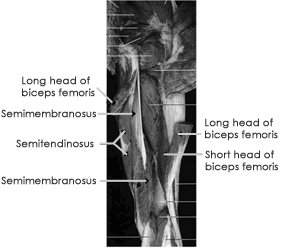6 Figtree Drive Sydney Olympic Park NSW 2127
Hamstring Injuries
Hamstring injuries occur when excessive load is placed on the hamstring muscle causing it to fail damaging the muscle fibres. This causes initial bleeding at the injury site (during the first 24-48hours) after which an inflammatory process occurs .The severity of muscle injury is graded into 3 levels.
Grade 1: up to 50% of the muscle fibres have been damaged (approx 2-3 weeks recovery)
Grade 2: 50-95% of muscle fibres have been damaged (approx 3-5 weeks recovery)
Grade 3: total muscle rupture (approx up to 6 weeks or greater recovery)
The hamstrings work to slow your leg down in the last part of the swing phase (as leg swings through) and then act to extend your hip in the first half of stance phase ( weight bearing) especially when running or kicking. The faster the pace of running the more load that is placed on the hamstring muscles and the more likely they are to be injured.
Hamstring injuries are the number 1 injury in the AFL accounting for the most game time missed by injured players. This is also true for our elite Sprint, Jumps and Hurdles - Track and Field athletes.
Signs and Symptoms
- Pain will be located to the hamstring region at the back of the thigh.
- In severe injuries swelling and bruising may be noted usually up 24-48 hours post injury
- Injury will be a result of a specific incident when local pain to the hamstring will be noted for example running fast, side stepping or over stretching.
- Pain will be noted in the back of the thigh when stretching, palpating or contracting the hamstring muscle.
Self Management
Correct action in the first 24-72 hours is critical to reduce the severity of injury.
- Rest – from aggravating activities, if something hurts don’t do it as it will be re injuring the muscle
- Compression- can be by a compression or tubi grip bandage to reduced swelling
- Ice for the first 48-72 hours or whenever there is pain. Remember to always wrap ice in a towel as direct contact will cause an ice burn. Ice 3-4 x a day for 15-20 minutes or till the area feels numb.
- Don’t stretch in the early phases as it can aggravate the injury.
How treatment can help
The sooner appropriate treatment occurs generally the better the outcome.
Physiotherapy
- Will aid in diagnosing whether the problem is a muscle tear or referred from other areas.
- Will initially reduce inflammation and then when appropriate start to improve muscle range via appropriate stretching and soft tissue releases.
- Will use soft tissue releases to reduce build up of scar tissue at the tear site
- Will guide patients on the return of strength of the muscle which is vital to prevent re injury.
- Will guide patients back to activity by doing a graded return program reducing risk of re injury
- If other areas are considered to influence hamstring pain then address these.
Sports Physicians
- Will aid in the diagnosis of injury and whether other areas of the body may be influencing the injury.
- Order tests such as u/sound or MRI to investigate the extent of damage to give a more accurate window about likely return.
- Prescribe anti-inflammatories if appropriate (remember anti-inflammatories may be detrimental to muscle tears so consult physician before taking them)
Massage
Massage therapists may assist physiotherapists in breaking up scar tissue at tear site.

View all our fact sheets
Sydney Sports Medicine Centre
Level 2, NSWIS Building
6 Figtree Drive
Sydney Olympic Park
NSW 2127
Written Correspondence
PO Box 3275
Rhodes NSW 2138
(02) 9764 3131 (02) 9764 3443
Appointments are available for some disciplines:
Mon - Fri
Saturdays
6:30am - 7:30pm
6:30am - 1:30pm
Reception is open:
Mon - Thurs
Fridays
Saturdays
8:00am - 7:00pm
8:00am - 6:00pm
8:00am - 1:00pm
